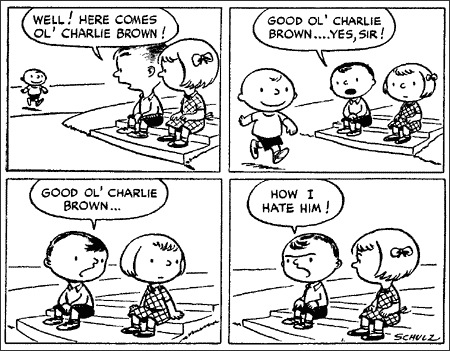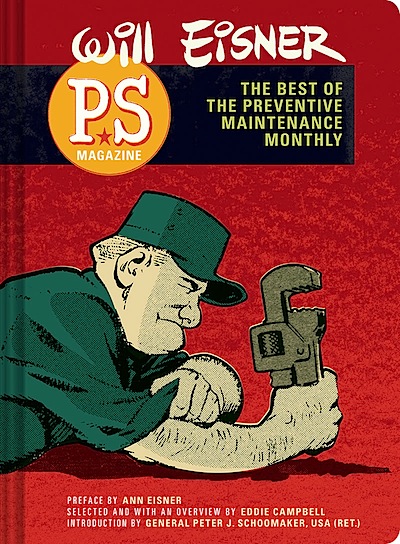Dr. Neil Cohn may soon become one of the most quoted people in the comics world. That’s because he’s a scientist who has been studyinghow our brains react to reading comics, and it turns out we process them much the same as we do sentences:
At the same time, a freshly minted Ph.D. named Neil Cohn is watching the readout from my brain, an exercise he has repeated with some 100 subjects to date. Many people would consider tracking Peanuts or Calvin and Hobbes comic strips unworthy of scientific inquiry, but Cohn begs to differ. His evidence suggests that we use the same cognitive process to make sense of comics as we do to read a sentence. They seem to tap the deepest recesses of our minds, where we bring meaning to the world.
The Costa Prize was right! So was Will Eisner!
The most tantalizing result of Cohn’s study (recently published in Cognitive Psychology) emerged when he showed subjects panels arranged so that they had a narrative arc but didn’t add up to a meaningful story. They were the equivalent of grammatically correct but meaningless sentences. The linguist Noam Chomsky, who published pioneering ideas about language in the 1950s, offered a famous example of such a sentence: “Colorless green ideas sleep furiously.”
Cohn found that when he showed subjects such “colorless green” panels, they experienced a weaker left anterior negativity response than when they read garbled panels. The result suggests that although participants struggled to understand the panels, they still recognized an underlying logic to them, supporting the idea that we depend on a visual grammar in comics in order to make sense of them.
Of course, many frontiers in this science remain to be explored: While Peanuts elicited the same brain waves as did sentences, will giving subjects Garfield result in a more lasagna-like brain wave? I personally will not be satisfied until the brain waves of people reading Jim Balent comics are studied.






RT @Comixace: Scientist: Our brains read comics as sentences: Dr. Neil Cohn may soon become one of the most quoted peo… http://t.co/L …
RT @Comixace: Scientist: Our brains read comics as sentences: Dr. Neil Cohn may soon become one of the most quoted peo… http://t.co/L …
RT @Comixace: Scientist: Our brains read comics as sentences: Dr. Neil Cohn may soon become one of the most quoted peo… http://t.co/L …
RT @Comixace: Scientist: Our brains read comics as sentences: Dr. Neil Cohn may soon become one of the most quoted peo… http://t.co/L …
RT @Comixace: Scientist: Our brains read comics as sentences: Dr. Neil Cohn may soon become one of the most quoted peo… http://t.co/L …
RT @Comixace: Scientist: Our brains read comics as sentences: Dr. Neil Cohn may soon become one of the most quoted peo… http://t.co/L …
RT @Comixace: Scientist: Our brains read comics as sentences: Dr. Neil Cohn may soon become one of the most quoted peo… http://t.co/L …
RT @Comixace: Scientist: Our brains read comics as sentences: Dr. Neil Cohn may soon become one of the most quoted peo… http://t.co/L …
RT @Comixace: Scientist: Our brains read comics as sentences: Dr. Neil Cohn may soon become one of the most quoted peo… http://t.co/L …
Reading Garfield will produce brainwave patterns similar to reading a recipe for unspiced lasagna.
Reading the work of Jim Balent produces patterns similar to reading e-mail from Pretty Croatian Ladies Seek Men 30+ for True Love & Life Partner!
I went to his panel at NYCC in 2011.
He’s great because he speaks the language of pure academia but in a way knuckleheads like me can understand.
Anyone who has played Scott McCloud’s Five Card Nancy knows just how true it is that our brains start making narrative sense out of nonsense.
When science finally decodes “Cow Tools”, that is when the secrets of abstract narrative (words and pictures) will be known.
When that glorious day arrives, we will not need inkblots or word association. We will be able to decode a person’s psyche, and influence it like a two-dimensional Radiance City.
—
http://en.wikipedia.org/wiki/Colorless_green_ideas_sleep_furiously#Related_and_similar_examples
The Exquisite Corpse is a well known example, as are Mad Libs. Alan Moore did something similar, but not quite, with “The Worm”.
If you really want to curve your brain waves, try to parse:
“Buffalo buffalo Buffalo buffalo buffalo buffalo Buffalo buffalo.”
or
“James while John had had had had had had had had had had had a better effect on the teacher.”
Or perhaps “Lion-Eating Poet in the Stone Den” (read it in the original Chinese!) 《施氏食獅史》
Or “Daddy, what did you bring that book that I don’t want to be read to out of about Down Under up around for?”
And garden path sentences… “The old man the boat.”
and Paraprosdokian…
“I like going to the park and watching the children run around because they don’t know I’m using blanks.” —Emo Philips
Ah… fun with Wikipedia!
And then there’s semantic satiation, where multiple repetition causes one to lose recognition of a particular word. Sort of like reading a book full of Garfield spider comic strips.
RT @Comixace: Scientist: Our brains read comics as sentences: Dr. Neil Cohn may soon become one of the most quoted peo… http://t.co/L …
RT @Comixace: Scientist: Our brains read comics as sentences: Dr. Neil Cohn may soon become one of the most quoted peo… http://t.co/L …
Cohn mixes semantic theories from the 60’s with cognitive theories from the 80’s. It’s step ahead from McCloud’s formalism from the 50’s, and Cohn is actually a scientist, but that’s really nothing to raise eyebrows in scientific circles of today. At least not here in Europe. Good to have some of this stuff in discussion around anyway, especially in the usually theory-resistant fan community.
Zeparu:
So who’s on the top of the heap in Europe these days?
Comments are closed.